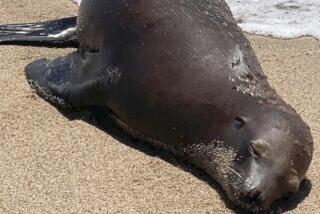Laser Used in Bid to Save Rare Fox : Wildlife: Doctors try experimental surgery to remove a cancer from one of the 2,000 members of a threatened species remaining on Santa Catalina Island.
- Share via
IRVINE — Fauna, a rare Santa Catalina Island fox found partially blind and wandering near Avalon Airport in 1984, underwent experimental laser surgery at UC Irvine on Wednesday for cancer in an ear, a new procedure not yet approved for humans.
The five-pound fox, which became a celebrity on the island after she was rescued at the airport, recently developed a tumor the size of a golf ball on her right ear.
Her only chance for survival lay in the hands of Dr. George Peavy, veterinary director at UC Irvine’s Beckman Laser Institute and Medical Clinic, where experimental diode lasers are being used to remove cancers.
The procedure, called photodynamic therapy or PDT, has not been approved by the federal Food and Drug Administration for use on humans and still is being developed by scientists at Beckman Institute and Lawrence Livermore National Laboratory.
In an FDA-approved experiment, photosensitive dyes were injected into Fauna’s bloodstream Monday night, where they traveled through the fox’s body and permeated the cancer tissues.
Peavy aimed the diode laser into the ear canal, where the beam activated the photosensitive dye, destroying the cancer cells.
Rosse said she hopes to see the procedure approved in three to five years. Its major advantage over conventional treatment, such as chemotherapy, she said, is that it selectively destroys cancer cells and has no side effects.
“With this process, the healthy cells surrounding the cancer cells are not destroyed,” Rosse said.
Because the cancer was so extensive, the fox’s right ear had to be removed, but the doctors hope that the treatment destroyed the cancer that had spread to the middle ear, deep into the canal.
Fauna awoke about 45 minutes after the two-hour surgery and was transported to veterinarian Matt Wyatt’s clinic in Anaheim, where she will remain under his care for the next six weeks.
“Things went better than expected,” Peavy said.
They hope to return Fauna within a month and a half to the habitat built for her on the island, where about 2,000 Santa Catalina Island foxes, a threatened species, remain.
More to Read
Sign up for Essential California
The most important California stories and recommendations in your inbox every morning.
You may occasionally receive promotional content from the Los Angeles Times.













